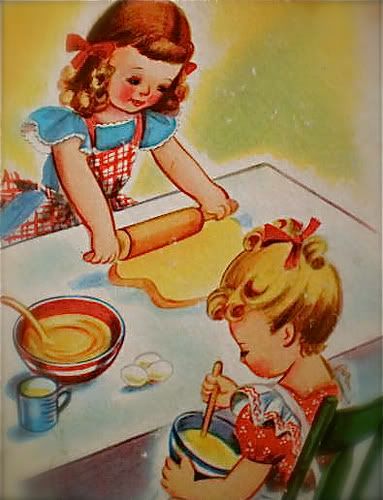
So, I see you're here for the Second Batch.
Now we know you love to eat books. Don't deny it. I saw you drooling and licking some of the cookbooks from the First Batch. Oh, you don't actually eat the books, you just like to make and eat the food from the books?
Alrighty then, dig in:
THE LOUISA MAY ALCOTT COOKBOOK, compiled by Gretchen Anderson, pictures by Karen Milone (Little, Brown, 1985). How I love this little book; it contains 28 recipes grouped with scenes from Little Women and Little Men. What is especially notable is that the recipes were initially researched, tested, and compiled by Ms. Anderson when she was just nine years old! She did this for a school project, combining her love for Alcott's books with her favorite hobby, cooking. So, we start out with the famous Christmas morning scene, where the March girls decide to take their breakfast to a poor family. To authentically recreate this, you might try Buckwheat Cakes, Muffins, or Farina Gruel. Or, remember when Marmee was sick in bed with a cold and the girls fixed her breakfast? They made an Omelet with Baking Powder Biscuits.
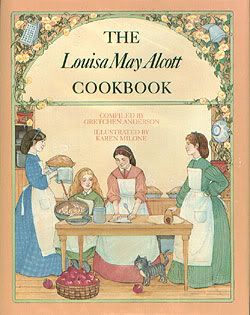
Now, if you're like Jo, with the best of intentions, but a disaster in the kitchen, you'll need more practice (with the Fire Department on alert). But if she could make Molasses Candy, so can you. The recipes from Little Men are solid, traditional American fare, such as Gingerbread, Steak and Potatoes, and Apple Pie. Can't go wrong with those, and all the recipes are rated for level of difficulty. A word about Karen Milone's pen-and-ink drawings: brilliant! Aside from book scenes, she's diagrammed some of the cooking techniques -- little eggs cracked in bowls! Little rolling pins! Squee!
PETER RABBIT'S NATURAL FOODS COOKBOOK, by Arnold Dobrin (Frederick Warne, 1977). Of all the literary cookbooks I own, I've used this one the most. It contains 33 simple recipes, with an emphasis on using fresh, unprocessed, whole foods for: Breakfast and Breads, Sandwiches, Vegetables, Salads, Soups and Desserts. Lots of light dishes made of fruit and veggies -- not for carnivores (what do you expect, Peter was a vegetarian)! I like the use of honey rather than refined sugar, and yogurt as a substitute for mayonnaise. My favorite is Fierce Bad Rabbit's Carrot-Raisin Salad, but there's also goodies like Squirrel Nutkin's Banana-Nut Loaf, Old Mrs. Rabbit's Hearty Vegetable Soup, and Flopsy, Mopsy and Cottontail's Fresh Blueberry Cobbler. No quotes or excerpts are included, but the 7" x 7-1/2" treasure is adorned with Potter's lovely illustrations throughout.
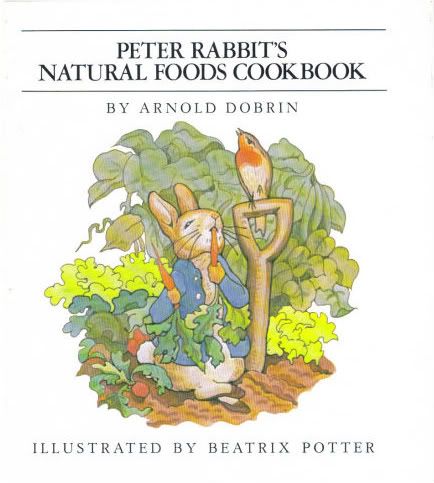
(See also):
PETER RABBIT'S COOKERY BOOK, compiled by Anne Emerson (Frederick Warne, 1980). Twenty-one more recipes, mostly for teas and light lunches, such as Hunca Munca's Rice Pudding and Pigling Bland's Porridge.
THE PETER RABBIT AND FRIENDS COOK BOOK by Naia Bray-Moffatt (Frederick Warne, 1994). Fifteen recipes, including gems like Samuel Whiskers' Roly-Poly Sausages and Peter Rabbit's Party Carrot Cake.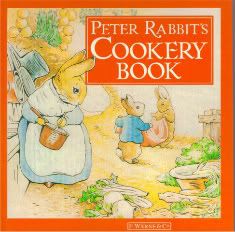

THE POOH COOK BOOK by Katie Stewart, pictures by Ernest Shepard (Methuen, 1971). A honey of a collection containing 58 recipes for all the bear essentials: Smackerels, Elevenses, Teas, Picnics and Expositions, Lunches and Suppers, Desserts, Parties, and Christmas, plus Hot and Cold Drinks. Honey is the favored ingredient, of course, and for bears of very little brain, the easiest recipes are marked with an asterisk. Start with Cinnamon Toast and work your way up to Honey Spice Cake and Spaghetti Supper. If you get stuck, peruse the Pooh quotes and nibble on the pen-and-ink doodles.

THE REDWALL COOKBOOK by Brian Jacques, pictures by Christopher Denise (Philomel, 2005). What an absolute treasure this book is! You don't need to be a Redwall fan to love this collection of three dozen recipes, grouped by the four seasons. The recipes of each section are tied together with a charming new tale featuring familiar Redwall characters, such as Friar Hugo, Pansy, and other adorable Dibbuns, scurrying about the kitchen preparing micey faves like Honeybaked Apples, Hare's Pawspring Vegetable Soup, and Afternoon Tea Scones with Strawberry Jam and Cream. Since Mr. Jacques originally wrote the series for children of a blind school, he is in the habit of describing everything in lavish sensory detail, especially all the food! The full color acrylic and charcoal illustrations are gorgeous -- rich, endearing, engaging, and of course, totally delish. Be sure to "serve warm with a generous helping of storytelling magic."
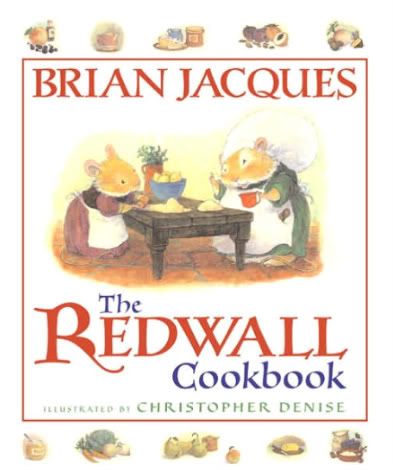
ROALD DAHL'S REVOLTING RECIPES, compiled by Josie Fison and Felicity Dahl, illustrated by Quentin Blake, with photographs by Jan Baldwin (Viking, 1994). "Nose bags on!" "Grub's up!" Prepare to be totally disgusted! Dang, but this cookbook is a lot of fun -- the only one so far with actual photographs of the finished recipes, embellished with classic Quentin Blake quirky drawings.
Or would it have been better not to feast our eyes on such gag-worthy specialties as Snozzcumbers, Mosquitoes' Toes and Wampfish Roes Most Delicately Fried, or Wormy Spaghetti? You get the picture. Everything here is totally Dahlian. Where else could you find a recipe for Lickable Wallpaper or Candy-Coated Pencils for Sucking in Class? No, I haven't actually tried any of these; just reading the ingredients and seeing the pictures is a feast in itself. But reviewers have unanimously rated the recipes as surprisingly delectable, tasting much better than they sound. I will have to try Hair Toffee to Make Hair Grow on Bald Men for Len!
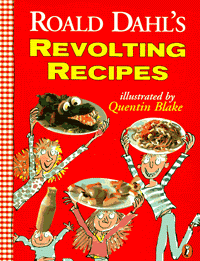
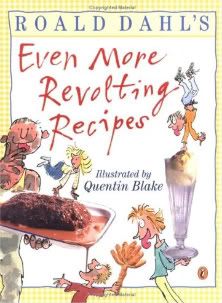
(See also):
ROALD DAHL'S EVEN MORE REVOLTING RECIPES, compiled by Lori-Ann Newman, pictures by Quentin Blake, photos by Jan Baldwin (Viking, 2001). Who could resist another big helping of the same? I am especially interested in A Plate of Soil with Engine Oil and Hot Noodles Made from Poodles on a Slice of Garden Hose.

ONCE UPON A RECIPE by Karen Greene (New Hope Press, 1987). This classic perfectly blends great content (healthy recipes), visual appeal (hand tinted antique woodblock prints), and loads of extras that both inform and inspire (book quotes, tips for preparation and serving, and sample menus). The author's intent was for each page to stir a different dream, and the result is enchanting. Prepare to enter the magical place where food and imagination meet.
Turn to "Morning Glory," where you can experience Shakespeare's Breakfast Sandwiches or Mrs. Tiggywinkle's Pineapple Right-Side-Up Muffins. When you're ready, go to "Bunches of Lunches," for Rumpelstiltskin's Pillows and Runaway Bunny's Custard. The Supper Club menu features Curiouser & Curiouser Casserole and Thumbelina Burgers. Don't worry. Before the day is done, indulge in a "Sweet Dream" -- perhaps Baloo's Mint Brownies or Selfish Giant Cookies. Also included are "Snacks and Sips," Very Nutritious Verses, and The Natural Pantry -- a wonderful primer about the key ingredients in the recipes, such as Maple Granules, Soy Milk, and Whole Grain Baking Mixes. With its nod to whole foods, this cookbook, when first published in 1987, was definitely ahead of its time.
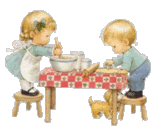
And with that, I'm off to do some holiday baking. Hope you'll check out these cookbooks, eat two Christmas cookies, and call me in the morning.
P.S. Do you know of any other good literary cookbooks? I'm always looking to add to my collection!!
Viewing: Blog Posts Tagged with: literary cookbooks, Most Recent at Top [Help]
Results 1 - 2 of 2
Blog: jama rattigan's alphabet soup (Login to Add to MyJacketFlap)
JacketFlap tags: thematic book lists, holiday treats, literary cookbooks, Add a tag
Blog: jama rattigan's alphabet soup (Login to Add to MyJacketFlap)
JacketFlap tags: thematic book lists, holiday treats, literary cookbooks, Add a tag

So, are you ready to get delicious?
Okay, I know you're already scrumptiously talented and have excellent taste when it comes to all things bookish, but I thought I'd tempt you today with some seriously divine, ambrosial offerings -- literary cookbooks.
At this very moment, I'm strapped down to my desk chair, because just thinking about excerpts from beloved, classic books alongside recipes derived from or inspired by the stories, propels me into a state of acute culinary bliss. *Butt rises in chair* See, this topic is actually dangerous -- but for you, I'll take my chances.
I've been collecting literary cookbooks for quite some time. While not all the dishes I've tried have knocked my socks off, I've always been happy just reading the recipes, and appreciating the connections they have with the works. For me, this is a satisfying way of enhancing the enjoyment of a story, since it deepens my understanding of character, historical context, and setting. And if the recipes just happen to be good, it's all gravy.
Though all of these cookbooks are based on children's books, they are actually suitable for cooks and would-be cooks of all ages. They're great for adults who like to revisit old favorites, and will provide hours of fun for grown-ups and kids to work together in the kitchen. And, unlike recipes from ordinary cookbooks, these are seasoned with just the right dash of literary flair.
FIrst batch:
FAIRY TALE FEASTS by Jane Yolen and Heidi E.Y. Stemple, pictures by Philippe Beha (Crocodile Books, 2006). A gorgeous collection featuring 19 retold fairy and folktales, and one original tale written by master storyteller, Jane Yolen, all paired with easy, kid friendly recipes compiled by Jane's daughter, Heidi.
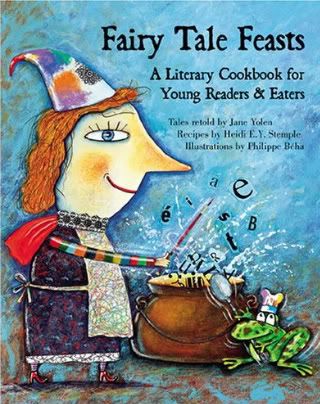
Breakfasts, Lunches, Soups, Dinners, and Desserts are all represented through classic stories like Little Red Riding Hood (Grandma's Potato Salad), Diamonds and Toads (Very French Toast), The Great Turnip (Mashed Turnips), and Brer Rabbit (Carrot Soup). Marginalia featuring folklore origins and food facts are equally delicious, and much of Stemple's good, standard fare will easily become family favorites. All is served up on thick, glossy pages adorned with Beha's bold color illos.
THE WIND IN THE WILLOWS COUNTRY COOKBOOK by Arabella Boxer (Methuen, 1983). If you're in a decidedly British mood, why not pack a hamper and join Toad, Mole, Ratty and Badger riverside? Here, you'll find Food for: Staying at Home, Staying in Bed, The Store Cupboard, Excursions, and Celebrations. The 100+ recipes range from simple to more complicated, and provide an opportunity to sample British standards like Bubble and Squeak, Jam Rolypoly, and Cornish Pasties. In honor of the characters, there are things like Toad Hall Trifle, Ratty's Potted Meat, and Moly's Marmite Soldiers. All garnished with memorable excerpts and line drawings by Ernest Shepard.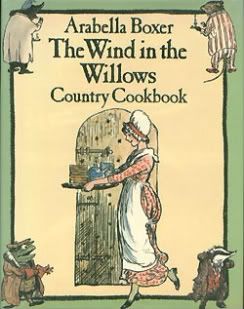
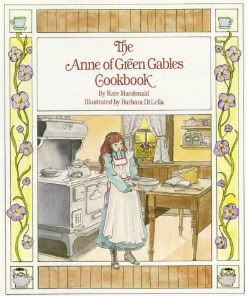
THE ANNE OF GREEN GABLES COOKBOOK by Kate Macdonald, pictures by Barbara DiLella (Oxford University Press, 1985). A slim volume featuring 25 recipes inspired by the Anne books and compiled by L.M. Montgomery's granddaughter. Ms. Macdonald reminds us that "Anne eventually became a good cook by following Marilla's advice." Probably the most memorable food scene of all is when Anne discovers a mouse drowned in the pudding sauce, and this is acknowledged with a recipe for Marilla's Plum Pudding and Warm Caramel Pudding Sauce (I would have tested it for you, but I'm afraid of mice)! Also of note: Diana Barry's Favourite Raspberry Cordial, Poetical Egg Salad Sandwiches, and Anne's Liniment Cake. A table of cooking tips and terms rounds out this lovely collection. Perfect for kindred spirits!
THE LITTLE HOUSE COOKBOOK by Barbara M. Walker, pictures by Garth Williams (Harper and Row, 1979). No doubt you've seen or possibly already own this classic of the genre. Food plays a big role in the Little House books; much of the action is centered on hunting for it, or growing, harvesting, preserving, serving and eating it. When Laura learned how to cook from Ma, she also learned social skills, about human communion. 

So much more than just a cookbook, this volume contains fascinating information about how food was obtained on the frontier, and how it was valued in American pioneer life during the late 19th century. All are authentic recipes from the period adapted for a modern kitchen, and as Ms. Walker states in her introduction, some are more historic than taste sensations. Who can resist Pancake Men, Doughnuts, or Apple Turnovers? Or maybe you'd like to learn how to can, butcher a pig, or churn butter. This is the book that will instill an appreciation for the food on the table, as it traces its connection to the field, the orchard, and the barnyard.
(See also):
*THE LAURA INGALLS WILDER COUNTRY COOKBOOK , by William Anderson (Trophy, 1997), featuring 73 recipes Laura herself compiled at Rocky Ridge Farm in the 30's and 40's.
*My post about Almanzo Wilder's eating habits in Farmer Boy.
THE NARNIA COOKBOOK, commentary by Douglas Gresham, pictures by Pauline Baynes (HarperCollins, 1998). A thoroughly delightful collection of recipes for Breakfast, Lunch, Afternoon Tea, Dinner, Dessert and Drinks, all inspired by foods appearing in C.S. Lewis' Chronicles. Jack, as he was called, was quite a foodie himself, and included in the stories those dishes he himself loved. Did your mouth water when Edmund was tempted with Turkish Delight? I know I was jealous when Lucy had tea with Mr. Tumnus (as fauns are known to be very good cooks).

Douglas Gresham, whose mother, Joy, married Jack later in life, serves up interesting comments about each recipe, either about its culinary origins or place in the stories. Of course there are direct quotes from the books to transport us right back into the wardrobe. Recipes range from simple things like Buttered Eggs to the more challenging Roast Pheasant. Things I would not try: Stewed Eels, Pigeon Pie, Chicken Livers Calormene. Things I'm anxious to try: Lucy's Roast Apples, Sugar Topped Cake, Meat Pasties. Pen-and-ink and watercolor illos by Narnia's original illustrator, Pauline Baynes, are a real treat.

THE BOXCAR CHILDREN COOKBOOK by Diane Blain (Scholastic, 1992). Though not glossy or elaborately illustrated, this collection of standard recipes is one that will be returned to again and again. That's because most of the dishes included are what kids actually like already or would be willing to try. Examples: Pomfret Landing Milkshake, Explorer's Bacon, Boxcar Brown Bread, Benny's #1 Favorite Sandwich, Mike's Favorite Chicken Legs. Each recipe begins with the excerpt from the story that inspired it, followed by very clear step-by-step instructions. There's even a section on Campfire Cooking, with the gold standard of all camp favorites, S'Mores.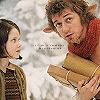 Hope these inspire you to create magic in the kitchen with your family. Look for them at your local library, add them to your personal wishlist, or purchase one as a holiday gift for someone special (you may have to search used bookstores for older titles).
Hope these inspire you to create magic in the kitchen with your family. Look for them at your local library, add them to your personal wishlist, or purchase one as a holiday gift for someone special (you may have to search used bookstores for older titles).
Stayed tuned for the Second Batch of literary cookbooks, coming soon!


